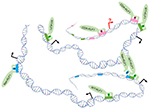KLF1 (Krüppel-like factor 1) variants in the pathogenesis of hematological diseases
DOI:
https://doi.org/10.18388/pb.2021_614Abstract
KLF1 (Krüppel-like factor 1) is an erythroid transcription factor involved in various stages of red blood cell formation. KLF1 plays key functions at the megakaryocyte-erythrocyte progenitor stage, where it is involved in the development of the erythrocyte lineage. It participates in the global expression of erythrocyte genes, playing a direct role in globin switching. KLF1 also participates in the final maturation of erythrocytes, controlling exit from the cell cycle and the enucleation process. KLF1 has a domain structure: N-terminal transactivation domain and C-terminal DNA-binding domain. Many variants (mutations) have been described in the KLF1 gene, which lead to the development of a whole spectrum of phenotypes: from clinically insignificant morphological changes, through mild changes, to severe pathological conditions. Two mutations are dominant. One occurs in mice and causes neonatal anemia with congenital spherocytosis (Nan), the other in humans and leads to congenital dyserythropoietic anemia type IV (CDA).

Published
Issue
Section
License
Copyright (c) 2025 Klaudia Kulczynska-Figurny, Mirosława Siatecka

This work is licensed under a Creative Commons Attribution 4.0 International License.
All journal contents are distributed under the Creative Commons Attribution-ShareAlike 4.0 International (CC BY-SA 4.0) license. Everybody may use the content following terms: Attribution — You must give appropriate credit, provide a link to the license, and indicate if changes were made, ShareAlike — If you remix, transform, or build upon the material, you must distribute your contributions under the same license as the original. There are no additional restrictions — You may not apply legal terms or technological measures that legally restrict others from doing anything the license permits.
Copyright for all published papers © stays with the authors.
Copyright for the journal: © Polish Biochemical Society.



